In recent years, a vivid green beverage has graced the cups of health enthusiasts, coffee shops, and Instagram feeds globally: matcha. This traditional Japanese tea isn’t a new invention; it’s a drink steeped in history, ceremony, and health benefits. But what exactly is matcha, and why has it garnered such widespread adoration?
Matcha is a finely ground powder made from green tea leaves. However, it’s not just any green tea. The tea plants destined for matcha production are treated with great care and shade-grown for several weeks before harvest. This unique cultivation method prompts the plant to produce more chlorophyll, resulting in the vibrant green hue matcha is renowned for. Moreover, this shading technique boosts the production of certain amino acids, infusing the tea with a rich flavour profile that’s both unique and alluring.
The origins of matcha trace back to Chinese and Japanese traditions. Powdered tea made its debut in China during the Tang Dynasty. But it was in Japan that this powdered tea evolved into what we recognize as matcha today. Brought over by monks who recognized the tea’s potential for aiding meditation due to its unique combination of caffeine and L-theanine, matcha quickly became ingrained in Japanese culture. This was especially so in the Zen Buddhist community, where it became an integral part of the ceremonial rituals.
The preparation of matcha is an art in itself. Unlike other teas where leaves are steeped and discarded, with matcha, the entire leaf is consumed. The traditional preparation involves sifting the powder to remove clumps, then whisking it with hot water using a bamboo whisk until a frothy, creamy consistency is achieved. While the modern world has introduced new ways of enjoying matcha, such as in lattes or smoothies, the traditional tea ceremony remains a revered practice in Japan. This ceremonial preparation isn’t just about making a beverage; it’s a meditative practice symbolizing respect, purity, and tranquillity.
But the allure of matcha isn’t solely based on its cultural significance. It boasts a range of health benefits that have contributed to its global popularity. Rich in antioxidants, particularly catechins like EGCG (epigallocatechin gallate), matcha is believed to help neutralize harmful free radicals in the body. Additionally, the amino acid L-theanine, combined with caffeine, offers a sustained energy boost, providing calm alertness without the jitters and subsequent crashes often associated with other caffeinated beverages.
The taste of matcha is as unique as its preparation and history. It offers a balance of flavours – vegetal, umami-rich, with a touch of astringency, rounded off with a gentle sweetness. The depth and nuances in its taste can vary based on its grade. From the highest quality ceremonial grade meant for traditional tea ceremonies to the culinary grades used in baking and cooking, matcha offers a spectrum of flavours to explore.
Matcha is more than just a drink; it’s an experience. It bridges the gap between ancient traditions and modern wellness trends. Whether one is drawn to matcha for its health benefits, its deep cultural roots, or simply its captivating taste and color, it’s undeniable that this green elixir resonates with many. As the world continues to embrace matcha, it’s a testament to the timelessness and universality of this vibrant green tea.
Table of Contents
What is matcha?
To recap, Matcha is a finely ground powder made from specially grown and processed green tea leaves. The green tea plants used for matcha are shade-grown for about three to four weeks before harvest, which prompts the plant to produce more chlorophyll and certain amino acids, leading to a richer flavour and vibrant green colour.
- Origin and History: Matcha has its roots in Chinese and Japanese traditions. While powdered tea was first consumed in China, matcha as we know it today is most closely associated with Japan, particularly with Japanese tea ceremonies.
- Production: After the tea leaves are harvested, they undergo a process of steaming, drying, and then removing stems and veins. What remains are the pure leaf parts, which are stone-ground to produce the fine, bright green matcha powder.
- Nutritional Profile: Matcha is rich in antioxidants, particularly catechins like EGCG (epigallocatechin gallate). It also contains amino acids like L-theanine, which combined with caffeine, provides a sustained energy boost without the jitters often associated with coffee.
- Preparation: Traditional preparation involves whisking the matcha powder with hot water using a bamboo whisk until a frothy consistency is achieved. The result is a vibrant green, creamy tea. Modern adaptations include matcha lattes, smoothies, and even baked goods.
- Taste: Matcha has a unique vegetal taste, umami-rich and slightly astringent, with a sweet aftertaste. The flavour can vary based on the quality and grade of the matcha powder.
- Grades: Matcha comes in various grades, ranging from ceremonial to culinary. Ceremonial-grade matcha is of the highest quality and is meant for drinking straight, while culinary-grade matcha is often used in cooking and baking.
- Caffeine: Matcha contains caffeine, but less than coffee. One advantage of matcha over other caffeinated beverages is the presence of L-theanine, which provides calm alertness without the typical caffeine crash.
Given its unique flavor and health benefits, matcha has gained worldwide popularity, not just as a drink but also as a flavoring in various foods and desserts.
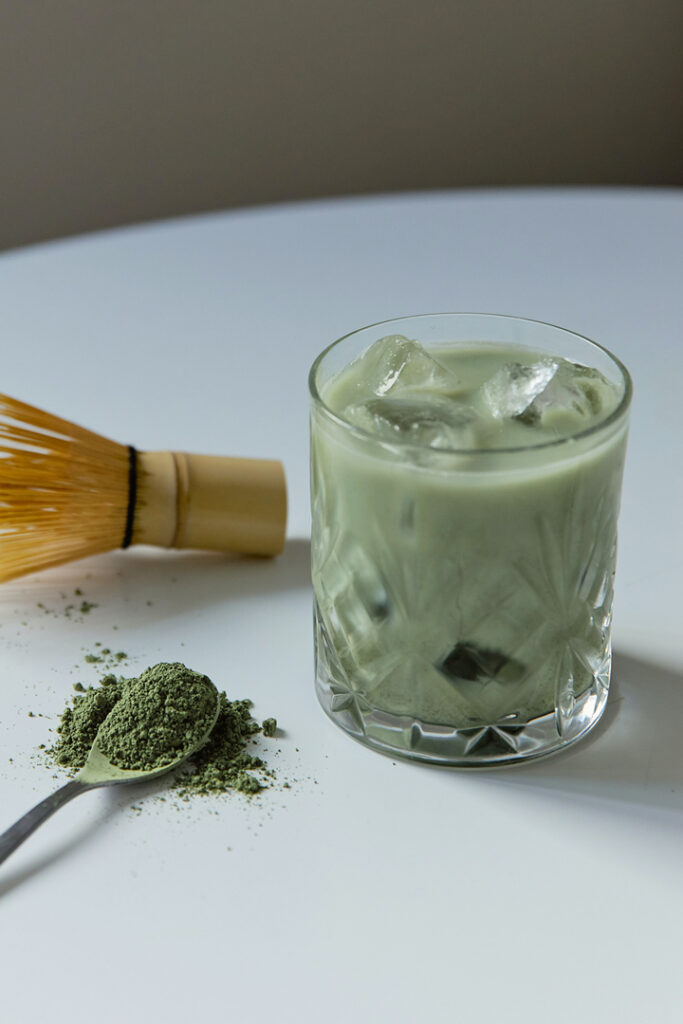
What are the health benefits of matcha?
Matcha, the finely powdered green tea from Japan, is lauded for its potential health benefits, many of which are attributed to its unique preparation and rich nutrient profile. Here are some of the most commonly cited health benefits of matcha:
- Rich in Antioxidants: Matcha is packed with catechins, a class of potent antioxidants. Among these, the most notable is epigallocatechin gallate (EGCG). Antioxidants combat oxidative stress in the body by neutralizing harmful free radicals, which can damage cells and contribute to chronic diseases.
- Enhanced Brain Function: Matcha contains a combination of caffeine and L-theanine, an amino acid known to promote relaxation without inducing drowsiness. This combo can help improve cognitive function, enhance mood, and increase alertness without the jittery side effects often associated with high-caffeine beverages.
- Supports Metabolism and Weight Loss: Some studies suggest that the catechins in matcha, especially EGCG, can boost metabolism and increase fat burning, aiding in weight loss efforts. Additionally, matcha can help enhance the effects of exercise on fat burning.
- Protects Heart Health: Regular consumption of green tea, including matcha, is linked to reduced levels of bad cholesterol and improved levels of good cholesterol. This can potentially lead to a reduced risk of heart disease.
- Detoxifies the Body: Because matcha tea leaves are shade-grown, they tend to have higher chlorophyll levels compared to regular green tea. Chlorophyll is known to be a natural detoxifier, helping to eliminate both chemicals and heavy metals from the body.
- Supports a Healthy Skin: The antioxidants in matcha can help reduce inflammation and free radicals that accelerate skin ageing. Some also claim that matcha can protect the skin from harmful UV rays, though one shouldn’t replace sunscreen with matcha!
- May Reduce Cancer Risk: The EGCG found in matcha has been studied for its potential anti-cancer properties. Some research suggests that this compound can inhibit the growth of cancer cells and reduce the spread of tumours in certain types of cancer, though more studies are required.
- Boosts Immune System: The various antioxidants, vitamins, and minerals in matcha may strengthen the immune system, helping the body avoid diseases and infections.
- Improves Oral Health: Matcha’s antibacterial properties can help reduce harmful bacteria in the mouth, potentially reducing the risk of cavities and gum disease. Furthermore, it can help neutralize bad breath.
- Stabilises Blood Sugar Levels: Preliminary studies suggest that green tea, including matcha, might help improve insulin sensitivity and reduce blood sugar levels, which is beneficial for managing diabetes.
It’s worth noting, however, that while matcha offers numerous health benefits, it shouldn’t be consumed in excessive amounts. Like all green teas, matcha contains caffeine, which can cause side effects in some individuals when consumed in large quantities. Additionally, due to its high concentration, the contaminants in the soil where the tea plants are grown can be more prevalent in matcha than in regular green tea. Therefore, it’s essential to choose high-quality, certified organic matcha when possible. Always consult with healthcare professionals before making significant changes to your diet, especially if you have existing health conditions or are on medications.
How is matcha different from regular green tea?
Matcha and regular green tea both originate from the Camellia sinensis plant, but they differ in several key aspects, from cultivation to preparation, appearance, taste, and nutrient profile. Here are the primary distinctions between matcha and regular green tea:
- Cultivation
- Matcha: Several weeks before harvest, matcha tea plants are shaded using bamboo mats or tarpaulins, reducing the amount of sunlight they receive. This shading increases chlorophyll production, resulting in a richer green colour and a boost in amino acid content, particularly L-theanine.
- Regular Green Tea: These plants are typically grown in full sunlight without the shading process used for matcha.
- Processing
- Matcha: After harvest, the leaves are steamed to halt oxidation, then dried and aged in cold storage to deepen flavour. Before grinding, the stems and veins are meticulously removed. The remaining leaf is then ground into a fine powder.
- Regular Green Tea: The leaves can be steamed (standard in Japanese green teas like sencha) or pan-fried (common in Chinese green teas). Afterwards, they’re rolled and dried. Unlike matcha, they are not ground into a powder.
- Preparation
- Matcha: The fine powder is whisked into the water, meaning you’re consuming the entire leaf. This is often done with a bamboo whisk in a bowl, creating a frothy, thick drink.
- Regular Green Tea: The leaves are typically steeped in hot water for several minutes. After steeping, the leaves are discarded, and only the infused water is consumed.
- Appearance
- Matcha: It’s a vibrant, bright green powder. When whisked into water, it becomes a thick, frothy beverage.
- Regular Green Tea: The appearance varies by type but generally consists of whole or fragmented tea leaves. The brewed tea’s colour can range from pale green to golden or light brown, depending on the specific variety.
- Taste
- Matcha: Due to the shading process, matcha has a rich, creamy flavour profile that’s umami-heavy with sweet undertones. Its taste is more concentrated than that of regular green tea.
- Regular Green Tea: The flavour varies by type and can be grassy, vegetal, nutty, or even slightly astringent. Japanese green teas tend to be more vegetal and sweet, while Chinese green teas might lean towards a nuttier or smokier flavour.
- Nutrient Profile
- Matcha: Since you’re consuming the entire leaf, matcha is denser in nutrients than regular green tea. It has more catechins, amino acids (like L-theanine), and other beneficial compounds per serving.
- Regular Green Tea: While still packed with antioxidants and beneficial compounds, the concentration is generally lower than in matcha because you’re only consuming the infused water, not the leaf itself.
- Caffeine Content
- Matcha: Contains more caffeine than regular green tea, given that you’re ingesting the entire leaf.
- Regular Green Tea: Contains caffeine, but usually less than matcha. The exact amount varies depending on factors like steeping time and leaf cut size.
Both matcha and regular green tea offer numerous health benefits and unique flavour profiles. The choice between them often depends on individual preferences and the specific experience one is seeking.
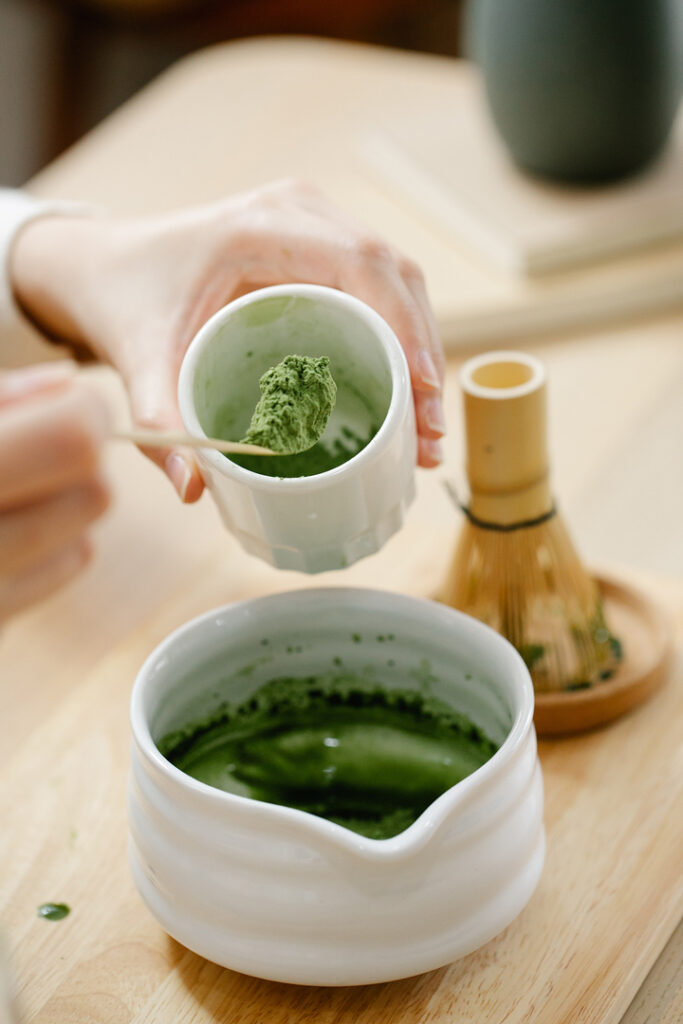
What does matcha taste like?
Matcha has a unique flavor profile that distinguishes it from other types of tea. The taste can be described as a harmonious blend of the following characteristics:
- Umami: Often described as the fifth basic taste after sweet, sour, bitter, and salty, umami is a savoury flavour. Matcha is rich in amino acids, especially L-theanine, which imparts this savoury depth. This umami flavour is a defining characteristic of high-quality matcha.
- Sweetness: Good quality matcha has an underlying natural sweetness. This is not the overt sweetness of sugar but rather a subtle, lingering sweetness that balances the umami and astringent qualities of the tea.
- Vegetal: Given its origin as a green tea leaf, matcha has a strong vegetal flavour. This can remind some of freshly steamed spinach or other green, leafy vegetables.
- Grassy: Some describe matcha as having a fresh, grassy note, especially if it’s a very vibrant green colour.
- Astringency: Matcha also has a slight astringency, which can be more pronounced in lower-quality versions. This astringency can leave a dry feeling in the mouth, similar to certain wines or other teas.
- Creaminess: High-quality matcha, when whisked properly, has a creamy texture and taste, almost like a liquid velvet. This creaminess balances the other flavours, adding to its complexity.
- Bitterness: Lower grades of matcha, or matcha that has been over-brewed with water that’s too hot, can exhibit a pronounced bitterness. However, a slight bitterness is expected and can complement the overall flavour profile of the tea.
The exact taste of matcha can vary based on its grade, preparation, and how it’s consumed. For example, ceremonial-grade matcha is generally smoother and has a more complex flavour profile than culinary-grade matcha, which might be used in cooking and baking.
How much caffeine is in matcha?
Matcha contains a higher concentration of caffeine compared to regular brewed green tea. This is because when you drink matcha, you are consuming the entire tea leaf, rather than just the water extracted from the leaves, as is the case with brewed tea.
The exact amount of caffeine in matcha can vary based on various factors, including the quality of the matcha, the part of the plant used, and how it’s processed. However, on average, a standard serving of matcha (about 1 teaspoon or 2 grams) contains approximately 30 to 70 milligrams of caffeine.
For comparison:
- A typical cup of brewed green tea contains about 20 to 45 milligrams of caffeine.
- A cup of black tea contains approximately 40 to 70 milligrams of caffeine.
- A cup of brewed coffee generally contains between 95 to 200 milligrams of caffeine, depending on factors like the type of bean, roast, and brewing method.
It’s worth noting that while matcha contains caffeine, it also contains an amino acid called L-theanine, which is known for promoting relaxation without inducing drowsiness. The combination of caffeine and L-theanine can provide a calm, focused energy, different from the jolt (and potential jitters) associated with coffee.
As always, individuals’ sensitivity to caffeine can vary, so it’s essential to monitor your body’s response and adjust your intake as needed. If you’re concerned about caffeine or have health conditions that can be affected by it, it’s a good idea to consult with a healthcare professional before making matcha a regular part of your diet.
Can matcha help with weight loss?
Matcha has been touted for various health benefits, one of which includes its potential to aid in weight loss. The primary mechanisms through which matcha might support weight management include:
- Boosting Metabolism: Green tea, including matcha, contains a class of antioxidants called catechins. The most abundant catechin in green tea is epigallocatechin gallate (EGCG). Studies have suggested that EGCG can help boost metabolism during moderate-intensity exercise and increase fat oxidation, potentially enhancing weight loss efforts.
- Appetite Suppression: Some research has indicated that the EGCG in green tea might have an effect on hormones that regulate hunger, potentially reducing appetite.
- Reduction of Fat Storage: Animal studies have shown that the polyphenols in green tea can reduce fat absorption in the diet, although this needs more confirmation in human studies.
- Stabilizing Blood Sugar Levels: Matcha may help stabilize blood sugar levels, which can reduce insulin spikes and crashes that can trigger hunger and fat storage.
- Enhancing Energy and Endurance: The combination of caffeine and L-theanine in matcha provides a sustained energy release. This can be beneficial for maintaining longer workouts without the jitters and crashes associated with other caffeine sources.
- Thermogenesis: Green tea can enhance thermogenesis, the body’s rate of burning calories. A study has shown that it can increase the thermic effect of food, which is the energy required to digest, absorb, and transport the nutrients you eat.
However, there are a few things to keep in mind:
- Magnitude of Effect: While matcha can aid in weight loss, it’s not a silver bullet. The effects, while positive, are modest. Sustainable weight loss requires a combination of a balanced diet, regular exercise, and other healthy lifestyle choices.
- Caffeine Sensitivity: Matcha contains caffeine, which can be problematic for individuals who are sensitive to it. It’s essential to monitor your intake if you’re prone to insomnia, anxiety, or any other caffeine-related issues.
- Quality Matters: Not all matcha powders are created equal. It’s vital to choose a high-quality, pure matcha powder without additives, fillers, or excessive amounts of heavy metals.
- Caloric Additions: If you’re drinking matcha lattes with added sugars and milks, the calorie count can add up, potentially offsetting some of the weight loss benefits.
While matcha can be a valuable addition to a weight loss regimen due to its metabolism-boosting and fat-burning properties, it should be incorporated as part of a holistic approach to health and wellness. As always, before making any significant changes to your diet or health regimen, it’s wise to consult with a healthcare professional or nutritionist.
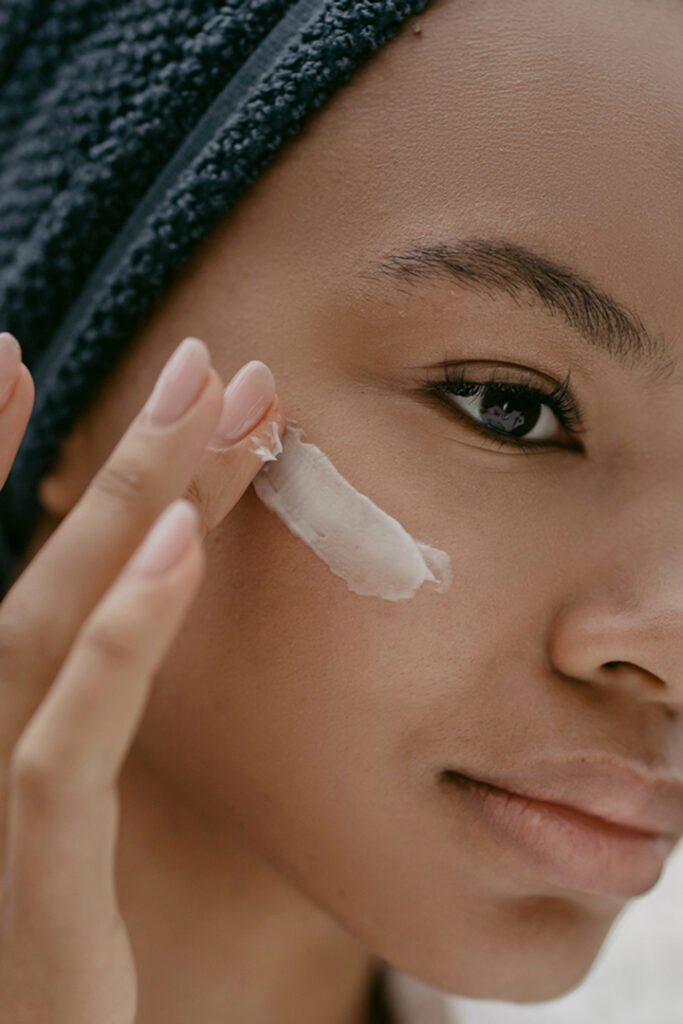
Is matcha good for your skin?
Matcha has been praised for its potential skin benefits when consumed and applied topically. The primary constituents of matcha that are beneficial for the skin include antioxidants, chlorophyll, and various polyphenols. Here’s how these components can positively impact the skin:
- Antioxidants: Matcha is rich in catechins, particularly epigallocatechin gallate (EGCG), which is known for its potent antioxidant properties. Antioxidants help combat free radicals in the body. Free radicals are unstable molecules that can damage cells, including skin cells, leading to premature ageing and various skin issues. By neutralizing these free radicals, the antioxidants in matcha can help maintain skin elasticity, brightness, and overall health.
- Anti-Inflammatory Properties: The EGCG in matcha also possesses anti-inflammatory properties. This can be beneficial in reducing skin redness, irritation, and inflammation. For individuals with conditions like rosacea or acne, matcha might help in soothing the skin.
- Protection Against UV Damage: While matcha should not replace sunscreen, the EGCG in it has been shown to offer some protection against the harmful effects of UV radiation, potentially reducing the risk of sunburn and skin damage.
- Detoxifying Effects: The chlorophyll present in matcha, which gives it its vibrant green colour, is known to have detoxifying properties. It might help remove impurities and toxins from the skin when applied topically.
- Improving Complexion: When consumed, the vitamins and minerals in matcha can nourish the skin from the inside out, promoting a healthy complexion.
- Oil Control: Some studies have suggested that the polyphenols in green tea can help reduce sebum production, potentially aiding those with oily skin.
Many beauty and skincare brands have incorporated matcha into their products, from face masks to cleansers. These products aim to harness the antioxidant and anti-inflammatory benefits of matcha directly on the skin. Homemade matcha face masks, often mixed with ingredients like honey or yoghurt, have also become popular.
However, while many of these benefits are promising, it’s essential to approach claims with a balanced perspective. Not everyone will experience the same results, and while matcha can be a valuable addition to skincare, it’s vital to ensure that the products used are of high quality. If applying matcha directly to the skin, it’s a good idea to do a patch test first to ensure no allergic reactions or sensitivities.
How to store matcha?
Proper matcha storage is essential to maintain its vibrant colour, delicate flavour, and potent nutrient profile. When exposed to light, heat, air, and moisture, matcha can quickly degrade, losing its freshness and efficacy. Here are some guidelines to store matcha correctly:
- Air-Tight Container: Ensure that your matcha is stored in an air-tight container. This will prevent exposure to oxygen, which can cause the powder to oxidize and lose its freshness. An air-tight seal also prevents moisture from entering the container, which could lead to clumping or mould growth.
- Keep Away from Light: Matcha’s vibrant green colour can fade when exposed to direct light, particularly sunlight. The loss of colour often indicates degradation in quality and nutrient content. Store your matcha container in a dark cupboard or drawer.
- Cool Storage: It’s advisable to store matcha in a cool place. While some recommend storing matcha in the refrigerator, it’s crucial to ensure that the container is entirely air-tight. Storing matcha in the fridge can expose it to moisture, especially if the container is frequently opened and closed. If you choose to refrigerate your matcha, let the container come to room temperature before opening it to prevent condensation from forming inside.
- Avoid Strong Odors: Matcha can absorb strong odours, so it’s essential to store it away from spices, coffee, or other aromatic substances.
- Original Packaging: Often, high-quality matcha comes in resealable, opaque, or foil-lined packages designed to protect it from light and air. It’s a good idea to keep the matcha in its original packaging and then place it inside another air-tight container for added protection.
- Consume Quickly: Even with proper storage, matcha is a perishable item. Once opened, it’s best consumed within a few months for optimal flavour and nutrient content. While it won’t necessarily “spoil” after this time, it will start to lose its vibrant colour and fresh taste.
- Check for Freshness: Always check your matcha for signs of moisture, mould, or an off smell, which can indicate spoilage.
- Separate Portions: If you buy matcha in bulk, consider dividing it into smaller portions. Store the bulk of it in the fridge or freezer in an air-tight container and keep a smaller amount in another container for daily use. This way, you limit the exposure of the entire quantity to air and light.
Are there any side effects of drinking matcha?
While matcha is generally safe and offers numerous health benefits, it is possible to experience side effects, especially when consumed in excessive amounts. Here, we have listed some potential side effects and considerations to remember.
Caffeine-Related Effects: Matcha contains caffeine, albeit in amounts lower than coffee. Some people may be more sensitive to caffeine than others. Overconsumption or sensitivity can lead to:
- Insomnia or disrupted sleep
- Jitters or restlessness
- Increased heart rate or palpitations
- Headaches
- Dizziness
- Upset stomach or diarrhoea
Lead Contamination: Tea plants, including those from which matcha is derived, can absorb lead from the soil, especially if grown near busy roads or in areas with a history of industrial pollution. Because matcha involves consuming the entire leaf, there’s potential for higher lead intake. Opting for high-quality, organic matcha from reputable sources can help mitigate this concern.
Drug Interactions: The high concentration of polyphenols in matcha might interact with certain medications. For example:
- Matcha might decrease iron absorption from food, so it’s advised not to drink it alongside iron-rich meals if you have an iron deficiency.
- Matcha can also affect blood pressure medications due to its caffeine content.
Liver Issues: Excessive consumption of green tea extracts has been linked to liver damage in rare cases. While these cases primarily involved green tea supplements rather than brewed tea, it’s still crucial to be mindful of consumption levels.
Digestive Issues: In some people, excessive consumption of matcha may cause an upset stomach or diarrhoea due to its high tannin content.
Allergies: It’s rare, but some people might be allergic to components in green tea or matcha, leading to skin rashes, irritation, or respiratory issues.
Bone Health: Excessive caffeine intake can lead to decreased calcium absorption, potentially affecting bone health. However, this is more of a concern with very high caffeine intake and is less likely with moderate matcha consumption.
To enjoy matcha safely
- Limit Intake: Moderation is key. For most individuals, one to two cups of matcha a day should be fine. If you’re sensitive to caffeine, you might want to start with a smaller amount and observe how your body reacts.
- Choose Quality Matcha: Invest in high-quality, preferably organic, matcha from reputable sources. This will ensure you’re getting a product with minimal contaminants.
- Consult a Healthcare Professional: If you have underlying health conditions, take medications, or have concerns about matcha consumption, it’s always a good idea to consult with a healthcare professional.
Remember that everyone’s body is different, and what works for one person might not work for another. It’s essential to pay attention to how your body responds and adjust your consumption accordingly.
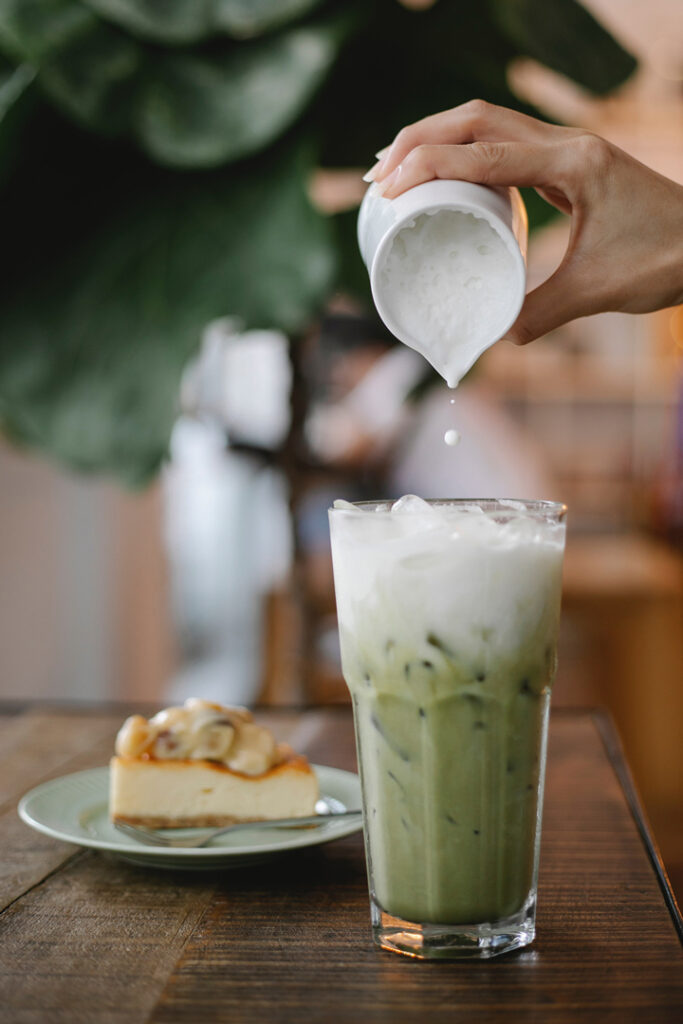
Is it healthy to consume matcha every day?
Consuming matcha every day can offer numerous health benefits thanks to its rich content of antioxidants, amino acids, vitamins, and minerals. However, as with many dietary components, it’s essential to consume matcha in moderation and be aware of potential concerns. Let’s delve into the pros and cons of daily matcha consumption:
Pros of Consuming Matcha Daily
- Rich in Antioxidants: Matcha is loaded with catechins, particularly epigallocatechin gallate (EGCG), a potent antioxidant known for its potential health benefits, including reducing the risk of heart disease and certain types of cancer.
- Boosts Metabolism and Burns Calories: Some studies suggest that green tea can enhance calorie burning, which may support weight loss efforts.
- Enhances Mood and Concentration: Matcha contains an amino acid called L-theanine, which, combined with caffeine, promotes sustained energy, alertness, and concentration.
- Supports Immune Function: The various antioxidants, polyphenols, and EGCG in matcha can help support the immune system.
- Improves Skin Health: The antioxidants in matcha may help protect the skin from UV damage and improve overall skin health.
- Oral Health: Some studies suggest that green tea can help reduce bad breath and has an antimicrobial effect against cavity-causing bacteria.
Potential Concerns with Daily Matcha Consumption
- Caffeine Content: If you’re sensitive to caffeine or consume other caffeinated products, you might exceed your preferred caffeine intake. Overconsumption of caffeine can lead to restlessness, insomnia, headaches, dizziness, and other symptoms.
- Lead Contamination: Tea plants can absorb lead from the soil, especially if grown near busy roads or in areas with industrial pollution. Given that matcha involves consuming the whole leaf, it’s essential to choose high-quality, preferably organic, matcha from reputable sources.
- Inhibition of Iron Absorption: The tannins in green tea, including matcha, can inhibit the absorption of non-heme iron (the type found in plant-based foods). It’s recommended to avoid consuming matcha with iron-rich meals, especially if you have iron deficiency concerns.
- Potential Drug Interactions: Matcha might interact with certain medications, including those affecting blood pressure and heart rate, due to its caffeine content.
- Liver Concerns: While rare and more commonly associated with green tea extracts (supplements), there have been reports of liver issues related to excessive green tea consumption.
How often should I drink matcha?
The frequency with which one should drink matcha largely depends on individual preferences, tolerance to caffeine, and specific health objectives. Here are some guidelines to consider:
- Caffeine Content: A standard serving of matcha (1 teaspoon or about 2 grams of powder) typically contains 30-70 mg of caffeine, depending on the quality and preparation. For reference, a cup of brewed coffee usually contains 95-200 mg of caffeine. If you’re sensitive to caffeine or looking to manage your caffeine intake, you’ll want to adjust how often you consume matcha accordingly.
- General Recommendation: For many people, consuming 1-2 cups of matcha daily is considered both safe and beneficial. This frequency allows you to harness the health benefits of matcha, such as its antioxidant properties, without overloading with caffeine.
- Tolerance and Side Effects: Pay attention to how your body reacts. If you notice symptoms like jitteriness, insomnia, headaches, or digestive upset, it might be a sign that you’re consuming too much or drinking it too late in the day. Adjusting the quantity or timing of your matcha intake can help.
- Health Benefits: If you’re drinking matcha for its health benefits, such as its rich antioxidant content, then regular consumption (daily or every other day) can be beneficial. However, even occasional consumption can still offer some health advantages.
- Variety in Diet: As with many things, it’s essential to ensure variety in your diet. While matcha is beneficial, diversifying your sources of antioxidants and other nutrients will provide you with a well-rounded, holistic nutritional profile.
- Other Health Concerns: If you have specific health issues, such as anaemia (due to matcha’s potential to inhibit iron absorption) or a history of heart arrhythmias (due to caffeine), you’ll want to consult with a healthcare professional about how often you should consume matcha.
- Quality Matters: If you’re consuming matcha regularly, it’s particularly important to invest in a high-quality product, preferably organic, to minimize potential contaminants like pesticides or heavy metals. This is especially true because, with matcha, you’re consuming the entire tea leaf.
In conclusion, while 1-2 cups of matcha daily is a general guideline that works for many, the optimal frequency will vary based on individual needs and preferences. It’s always a good idea to listen to your body and adjust based on how you feel. If in doubt, consulting with a nutritionist or healthcare professional can provide personalized guidance.
Can you cook with matcha?
Absolutely! Matcha is not only consumed as a beverage but also as a versatile ingredient in cooking and baking. Its distinct flavour and vibrant green colour can elevate both the taste and aesthetics of various dishes.
When cooking or baking with matcha, a few things to keep in mind:
- Quality: Culinary-grade matcha is typically used for cooking and baking, as it’s more cost-effective than ceremonial-grade matcha. However, ensure it’s still of good quality to avoid a bitter taste.
- Heat: While matcha can handle some heat, excessive temperatures might degrade its beneficial compounds and alter its flavour. If the health benefits of matcha are a primary concern, consider adding it to recipes that don’t require prolonged high-heat cooking.
- Pairings: Matcha has a distinct taste, often described as earthy, vegetal, and slightly sweet. When introducing it to recipes, consider pairing it with flavours that complement it, such as vanilla, chocolate, almond, or berries.
Incorporating matcha into your culinary endeavours can add both flavour and health benefits to your dishes. Don’t be afraid to experiment!
Why is matcha so expensive?
Matcha can indeed be pricier than many other types of tea, and several factors contribute to its higher cost:
- Labour-Intensive Production: Producing matcha is a meticulous process. The tea plants are shaded for several weeks before harvest, which increases the chlorophyll content and gives matcha its vibrant green colour. After harvesting, the leaves are steamed, dried, and then carefully ground into a fine powder using stone mills. This grinding process is slow, with some mills producing only about 30 to 40 grams of matcha an hour.
- Quality of Leaves: Only the youngest, top leaves are picked to make high-quality matcha. These leaves have a finer texture and a sweeter, more delicate flavour compared to older leaves.
- Terroir: Just like wines, the taste and quality of tea can vary based on where it’s grown. Matcha from revered tea-growing regions in Japan, like Uji in Kyoto, can command higher prices due to the region’s reputation and unique soil and climatic conditions.
- Organic Farming: Organic matcha tends to be more expensive because organic farming practices are more labour-intensive, yield less produce compared to conventional methods, and require more rigorous certification processes.
- Storage and Freshness: Matcha doesn’t have a long shelf life compared to other teas. It can lose its freshness and vibrant colour relatively quickly. Producers need to invest in proper storage facilities and practices to ensure that matcha retains its quality until it reaches the consumer.
- Grading: There are different grades of matcha, from culinary to ceremonial. Ceremonial grade matcha, which is the highest quality meant for traditional tea ceremonies, is made from the finest, youngest tea leaves and is more expensive. Culinary-grade matcha, used primarily for cooking and baking, is typically less costly but can still be pricey if it’s of high quality.
- Import Costs: If you’re purchasing matcha outside of Japan, import taxes, shipping fees, and other related costs can increase the price.
- Packaging: High-quality matcha is often sold in tins or special packaging that protects it from light and air, both of which can degrade its quality. This type of packaging can add to the cost.
- Popularity and Demand: The global surge in matcha’s popularity has led to increased demand. High demand combined with the labour-intensive production process can drive up prices.
While matcha can be expensive, it’s worth noting that a little goes a long way. A small amount of the powder can produce a flavorful cup of tea or be used as an ingredient in various recipes. If you’re considering investing in matcha, it’s essential to determine your purpose (drinking, cooking, or ceremonial) and choose a grade and brand that aligns with your needs and budget.
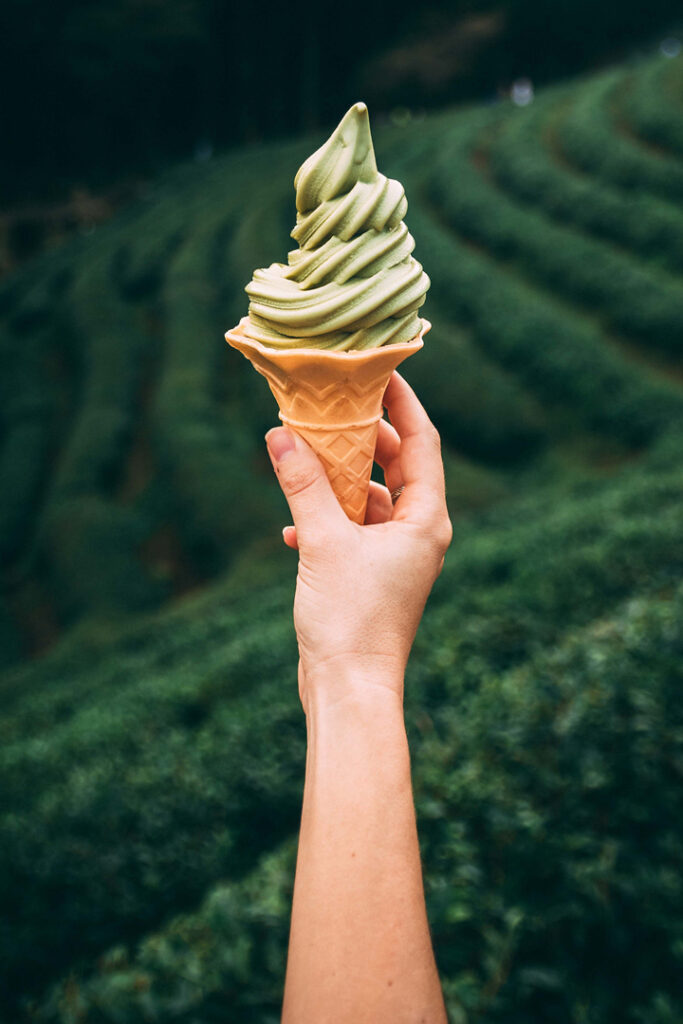
Will matcha stain my teeth?
Like many other beverages that are rich in tannins (e.g., coffee, red wine, black tea), matcha can potentially stain your teeth over time. Tannins are plant-based compounds that can adhere to dental enamel and lead to discolouration when regularly consumed.
Matcha has a vibrant green colour derived from chlorophyll. While the green hue in itself doesn’t cause staining, matcha also contains tannins, which can lead to discolouration. However, the staining effect of matcha might be less intense than that of beverages like coffee or red wine, but it’s still present.
There are a few steps you can take to minimize the potential staining effect of matcha:
- Drink water: After consuming matcha, rinse your mouth with water or drink a glass of water to help wash away any lingering particles.
- Use a straw: If you’re drinking a cold matcha beverage, using a straw can reduce the contact between the drink and your teeth.
- Brushing and Flossing: Regular brushing and flossing can help reduce the buildup of tannins on your teeth. However, it’s a good idea to wait at least 30 minutes after drinking acidic or tannin-rich beverages to brush, as the acidity can soften enamel, making it more vulnerable to abrasion.
- Regular Dental Cleanings: Professional cleanings can help remove surface stains and prevent deeper staining.
Matcha is acidic and regularly consuming acidic beverages can contribute to tooth enamel erosion, leading to sensitivity. It’s crucial to be mindful of this and take preventative measures, like not swishing the drink around in your mouth and following it with a rinse of water.
Traditional brewed green tea can also stain teeth, possibly to a lesser degree than black tea or coffee. Matcha, being a concentrated form of green tea where you consume the entire leaf, may have a more pronounced staining effect than regular brewed green tea.
While matcha has the potential to stain teeth over time, the risk can be mitigated with proper dental hygiene and preventative measures. If you’re concerned about staining, consider discussing it with your dentist or dental hygienist for personalized advice and recommendations.
Does matcha make you poop?
Matcha, like other forms of green tea, can influence digestion and bowel movements in some people. Here are some reasons why matcha might have a laxative effect:
- Caffeine: Matcha contains caffeine, which can stimulate the bowel and act as a mild diuretic. For some people, caffeine can accelerate colon activity, leading to increased bowel movements.
- Catechins: Green tea, including matcha, is rich in catechins, a type of antioxidant. Higher doses of catechins can have a laxative effect on the digestive system.
- Tannins: The tannins present in matcha can sometimes either cause constipation or, conversely, stimulate the bowel, depending on the individual and the amount consumed.
- Increased Fluid Intake: If you’re drinking matcha as a tea, the increased fluid intake can contribute to softer stools and more frequent bowel movements.
- Gastric Irritation: Some people might find that green tea irritates their stomach, leading to loose stools or diarrhoea. This is more likely to occur if consuming matcha on an empty stomach.
- Other Ingredients: If you’re consuming matcha in a blend or as part of a food product, other ingredients might also contribute to its effect on digestion.
It’s worth noting that the effects of matcha on digestion can vary widely among individuals. While some people might experience increased bowel movements, others might not notice any change. As with any dietary component, moderation is key. If you’re new to matcha, it might be helpful to start with smaller amounts and observe how your body reacts.
Can I drink matcha when pregnant?
If you’re pregnant, it’s always best to consult with your healthcare provider about any dietary changes or concerns, including consuming beverages like matcha. However, here are some general considerations regarding matcha consumption during pregnancy:
- Caffeine Content: Matcha contains caffeine, although the amount can vary based on preparation and quality. The American College of Obstetricians and Gynecologists (ACOG) suggests that pregnant women limit their caffeine intake to less than 200 mg per day (roughly the amount found in one 12-ounce cup of coffee). Consuming caffeine in moderation during pregnancy is generally considered safe, but excessive caffeine intake might be associated with an increased risk of miscarriage or low birth weight. Depending on the specific matcha and how it’s prepared, a typical serving can contain anywhere from 30 to 70 mg of caffeine or even more.
- Lead Contamination: Some tea leaves, especially those grown in industrial areas or close to busy roads, might absorb lead from the environment. Most of this lead remains in the tea leaves when you drink brewed tea. However, with matcha, since you’re consuming the entire leaf in powdered form, there’s a potential for higher lead intake. While this is a concern with many teas and not just matcha, it’s something to be aware of during pregnancy. It might be wise to choose organic matcha or matcha sourced from reputable regions and producers.
- Other Compounds: Green tea, including matcha, contains antioxidants and compounds like catechins. In very high amounts, these can interfere with nutrient absorption. For instance, excessive green tea consumption might inhibit the absorption of folic acid, an essential nutrient during pregnancy.
- Digestive Effects: As mentioned in previous answers, matcha can influence digestion. Some pregnant women already experience digestive issues like constipation or diarrhoea, and matcha might exacerbate these in specific individuals.
- Stimulatory Effects: The combination of caffeine and theanine (an amino acid found in tea) can have a calming yet alert effect on the mind. While theanine is generally considered safe, it’s good to be aware of how your body responds to these compounds during pregnancy.
While consuming matcha in moderation during pregnancy might be safe for many women, it’s essential to be aware of its caffeine content and potential effects on nutrient absorption. If you enjoy matcha and want to continue consuming it during pregnancy, discuss it with your healthcare provider to determine an appropriate and safe amount.

How do you make matcha tea?
Making matcha tea is both an art and a simple process. The traditional Japanese method is meditative in nature, emphasizing mindfulness and respect. Here’s how you can prepare matcha tea, both in the traditional way and a more straightforward method.
Traditional Method
What You’ll Need:
- Matcha powder (preferably ceremonial grade for best flavor)
- A bamboo whisk (known as a “chasen”)
- A tea bowl (known as a “chawan”)
- A bamboo scoop (known as a “chashaku”) or a teaspoon
- A fine-mesh strainer (optional, for sifting)
- Hot water (not boiling, ideally around 175°F or 80°C)
Steps:
- Preheat the Bowl: Pour some hot water into the chawan to warm it up. After a few moments, discard the water and dry the bowl with a cloth.
- Sift the Matcha (optional but recommended): Using the chashaku or teaspoon, take 1-2 scoops of matcha powder (about 1-2 grams) and sift it through a strainer into the bowl. This step ensures there are no clumps, resulting in a smoother tea.
- Add Water: Pour roughly 2-4 ounces (60-120ml) of hot water into the bowl.
- Whisk: Using the chasen, whisk the matcha and water. Begin slowly to dissolve the powder, then whisk briskly in a back-and-forth motion (like the letter “M” or “W”) until the tea becomes frothy.
- Enjoy: Drink the matcha immediately, savouring its rich, creamy taste and texture.
Quick Method
What You’ll Need:
- Matcha powder
- A bowl or cup
- A whisk or spoon
- Hot water
Steps:
- Place 1-2 teaspoons of matcha powder in the bowl or cup.
- Add a small amount of hot water and mix it into a paste to ensure there are no clumps.
- Pour in the remaining water (2-4 ounces or 60-120ml).
- Whisk or stir vigorously until the tea is smooth and frothy.
- Drink and enjoy!
Whether you choose the traditional method or the quick method, the key is to use high-quality matcha powder. This ensures vibrant colour and a delightful taste, free from excessive bitterness. Adjust the amount of matcha and water according to your taste preferences. Some people prefer a thicker, more potent tea, while others opt for a lighter version. Experiment and find the balance that’s perfect for you.


